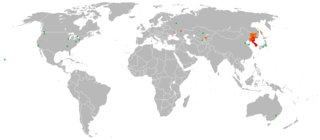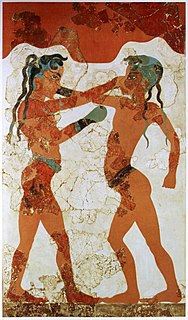
Martial arts are codified systems and traditions of combat practiced for a number of reasons such as self-defense, military and law enforcement applications, physical, mental and spiritual development; as well as entertainment and the preservation of a nation's intangible cultural heritage.

Neijia is a term in Chinese martial arts, grouping those styles that practice neijing, usually translated as internal martial arts, occupied with spiritual, mental or qi-related aspects, as opposed to an "external" approach focused on physiological aspects. The distinction dates to the 17th century, but its modern application is due to publications by Sun Lutang, dating to the period of 1915 to 1928. Neijing is developed by using neigong, or "internal exercises," as opposed to "external exercises",

Taekwondo is a Korean martial art, characterized by its emphasis on head-height kicks, jumping and spinning kicks, and fast kicking techniques.

Taiji, short for Tai ji quan, or T'ai chi ch'üan, is an internal Chinese martial art practiced for both its defense training, its health benefits and meditation. The term taiji refers to a philosophy of the forces of yin and yang, related to the moves. Though originally conceived as a martial art, it is also typically practiced for a variety of other personal reasons: competitive wrestling in the format of pushing hands, demonstration competitions and achieving greater longevity. As a result, a multitude of training forms exist, both traditional and modern, which correspond to those aims with differing emphasis. Some training forms of tàijíquán are especially known for being practiced with relatively slow movements.
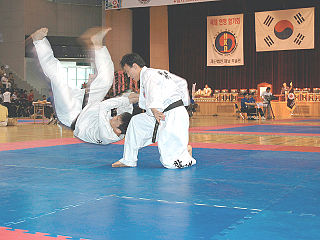
Hapkido is a highly eclectic Korean martial art. It is a form of self-defense that employs joint locks, grappling, and throwing techniques similar to those of other martial arts, as well as kicks, punches, and other striking attacks. It also teaches the use of traditional weapons, including knife, sword, rope, ssang juhl bong (nunchaku), cane, short stick, and middle-length staff, which vary in emphasis depending on the particular tradition examined.
Shaolin Kung Fu, also called Shaolin Wushu or Shaolin quan, is one of the oldest, largest, and most famous styles of wushu or kungfu. It combines Zen Buddhism and martial arts and originated and was developed in the Shaolin temple in Henan province, China during its 1500-year history. Popular sayings in Chinese folklore related to this practice include "All martial arts under heaven originated from Shaolin" and "Shaolin kung fu is the best under heaven," indicating the influence of Shaolin kung fu among martial arts. The name Shaolin is also used as a brand for the so-called external styles of kung fu. Many styles in southern and northern China use the name Shaolin.

Gōjū-ryū (剛柔流), Japanese for "hard-soft style", is one of the main traditional Okinawan styles of karate, featuring a combination of hard and soft techniques. Both principles, hard and soft, come from the famous martial arts book used by Okinawan masters during the 19th and 20th centuries, the Bubishi. Gō, which means hard, refers to closed hand techniques or straight linear attacks; jū, which means soft, refers to open hand techniques and circular movements. Gōjū-ryū incorporates both circular and linear movements into its curriculum, combining hard striking attacks such as kicks and close hand punches with softer open hand circular techniques for attacking, blocking, and controlling the opponent, including joint locks, grappling, takedowns, and throws.
Chinese martial arts, often named under the umbrella terms kung fu and wushu, are the several hundred fighting styles that have developed over the centuries in China. These fighting styles are often classified according to common traits, identified as "families", "sects" or "schools" of martial arts. Examples of such traits include Shaolinquan (少林拳) physical exercises involving Five Animals (五形) mimicry, or training methods inspired by Old Chinese philosophies, religions and legends. Styles that focus on qi manipulation are called internal, while others that concentrate on improving muscle and cardiovascular fitness are called "external". Geographical association, as in northern and "southern", is another popular classification method.

In martial arts, blocking is the act of stopping or deflecting an opponent's attack for the purpose of preventing injurious contact with the body. A block usually consists of placing a limb across the line of the attack.

Japanese martial arts refer to the variety of martial arts native to the country of Japan. At least three Japanese terms are used interchangeably with the English phrase Japanese martial arts.

Korean martial arts are military practices and methods which have their place in the history of Korea but have been adapted for use by both military and non-military personnel as a method of personal growth or recreation. The history of Korean martial arts can be traced as far back as the prehistoric era. The ancestors of modern Korean people migrated and settled in the Korean Peninsula as early as the 28th century BC, a geopolitical region besieged by thousands of known documented instances of foreign invasions. Consequently, the Korean people developed unique martial arts and military strategies in order to defend themselves and their territory.

Vovinam is a Vietnamese martial art. It was founded in 1936 by Nguyễn Lộc, but at that time it was silent until 1938. At the same time, he proposed the doctrine of "revolution of the mind" to encourage students to always renew. Vovinam is based on Vietnamese traditional subjects.

Tang Soo Do is a karate-based Korean martial art incorporating fighting principles from subak, as well as northern Chinese martial arts. The techniques of what is commonly known as Tang Soo Do combine elements of shotokan karate, subak, taekkyon, and kung fu.
Neigong, also spelled nei kung, neigung, or nae gong, refers to any of a set of Chinese breathing, meditation and spiritual practice disciplines associated with Daoism and especially the Chinese martial arts. Neigong practice is normally associated with the so-called "soft style", "internal" or neijia 內家 Chinese martial arts, as opposed to the category known as waigong 外功 or "external skill" which is historically associated with shaolinquan or the so-called "hard style", "external" or wàijiā 外家 Chinese martial arts. Both have many different schools, disciplines and practices and historically there has been mutual influence between the two and distinguishing precisely between them differs from school to school.
Contact sports are sports that emphasize or require physical contact between players. Some sports, such as mixed martial arts, are scored on impacting an opponent, while others, including rugby, require tackling of players. These sports are often known as full-contact, as the sport cannot be undertaken without contact. Other sports have contact, but such events are illegal under the rules of the game or are accidental and do not form part of the sport.

Breaking is a martial arts technique that is used in competition, demonstration and testing. Breaking is an action where a martial artist uses a striking surface to break one or more objects using the skills honed in their art form. The striking surface is usually a hand or a foot, but may also be a fingertip, toe, head, elbow, knuckle, or knee. The most common object is a piece of wood or brick, though it is also common to break cinder blocks, glass, or even a piece of metal such as steel bars. Glass is usually discouraged, since its shards may cause injury when broken.
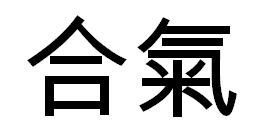
Aiki from a Japanese budo term, at its most basic is a principle that allows a conditioned practitioner to negate or redirect an opponent's power. When applied, the aiki practitioner controls the actions of the attacker with minimal effort and with a distinct absence of muscular tension usually associated with physical effort.

In many extant t'ai chi classic writings the dependence of t'ai chi ch'uan on Chinese philosophy is acknowledged. T'ai chi teachers have historically asserted that the principles of tai chi chuan practice can be applied to a student's lifestyle.
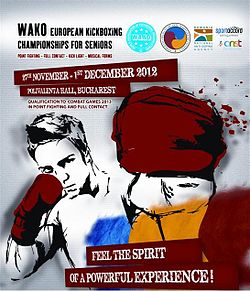
W.A.K.O. European Championships 2012 in Bucharest were the joint twenty-three European kickboxing championships held by the W.A.K.O. organization arranged by the Romanian Full-Contact Martial Arts Federation (F.R.A.M.C.) president Dorel Bulearcă. The first event was held the previous month in Ankara, Turkey. It was the first W.A.K.O. event to be held in Bucharest and Romania and involved over 550 amateur men and women from 35 countries across Europe.
